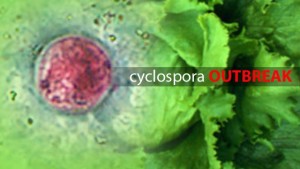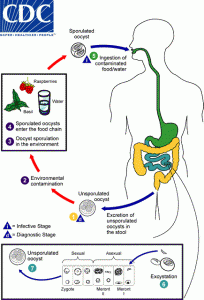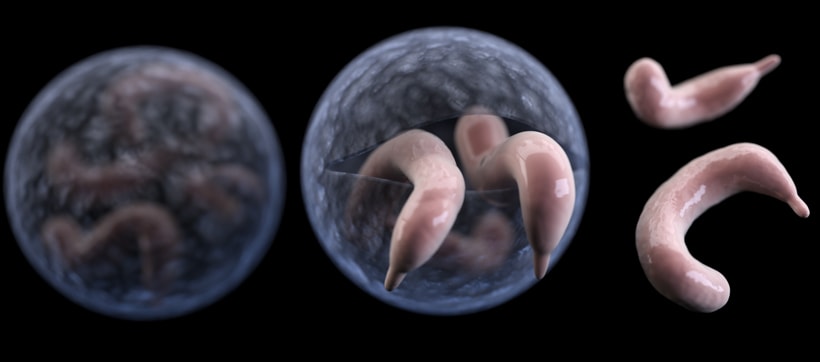Cyclospora Outbreaks are Hitting North America
Public health officials are warning about a series of Cyclospora outbreaks in US and Canada.

Source: http://www.foodpoisonjournal.com/foodborne-illness-outbreaks/fda-on-29-state-cyclospora-outbreak-tied-to-mexican-cilantro/#.VkWSAPlViko
From May to August 2015, 546 peoples from 31 states in US became sick due to Cyclospora infection. The U.S. Food and Drug Administration (FDA) indicated that this outbreak has been linked to imported fresh produce, including cilantro from the Puebla region of Mexico.
Around the same time, a total of 97 Cyclosporiasis cases were reported in Canada, mainly in Ontario. Two cases were hospitalized, and no deaths were reported. The source of this outbreak was not identified.
On October 17, CFIA announced that Costco Wholesale Canada is voluntarily recalling Alpine Fresh brand snap peas in Ontario due to possible Cyclospora contamination. At least 22 illnesses have been linked to the recalled snap peas.
What is cyclospora?
Cyclospora, a microscopic parasite, causes an intestinal infection known as cyclosporiasis. The parasite is typically found in imported fresh vegetables and fruits such as basil, cilantro, pre-packaged salad mix, mesclun lettuce, snow peas, and raspberries. People usually become infected with Cyclospora by ingesting food or water that has been contaminated with feces, and this parasite is most commonly found in tropical and subtropical countries. Cyclospora cannot be passed directly from one person to another.
The life cyle of cyclosporiasis:

Source: http://www.cdc.gov/parasites/cyclosporiasis/biology.html
Why I haven’t heard of it before?
The public may not be as familiar with Cyclospora as some other foodborne pathogens because Cyclospora only came to medical attention about 40 years ago. This parasite was once primarily a concern for developing countries, but since the 1990s there have been more and more Cyclospora outbreaks in North America linked to contaminated imported fresh greens.
How serious is the illness?
Cyclospora is generally considered as a low-risk foodborne pathogen. Infected people usually experience watery diarrhea, stomach cramps, fatigue, weight loss, and abdominal bloating, while some people do not get sick at all. The illness may last from a few days to a month. People who have previously been infected can become infected again. The combination of 2 antibiotics, trimethoprim (TMP) and sulfamethoxazole (SMX), is used to treat Cyclospora infection.
How can it be prevented?
According to the US Centers for Disease Control and Prevention (CDC), avoiding food or water that might have been contaminated with stool is the most efficient way to prevent cyclosporiasis. Contaminated food may not look or smell spoiled. Both washing fresh produce and treating it with chlorine or iodine are not sufficient enough to eliminate the parasite. Microbial food safety hazards for fresh fruits and vegetables, including Cyclospora, must be controlled by addressing good agricultural practices (GAPs) and good manufacturing practices (GMPs).
Here is an educational video about Cyclospora:
https://youtube.com/watch?v=dVFRgmZpTfQ%3Frel%3D0%26autoplay%3D1
For more information, please check out (References):
CDC, 2015. Parasites – Cyclosporiasis (Cyclospora Infection). Retrieved from http://www.cdc.gov/parasites/cyclosporiasis/
CFIA, 2015. Food Recall Warning – Alpine Fresh brand Snap Peas recalled due to Cyclospora. Retrieved from http://www.inspection.gc.ca/about-the-cfia/newsroom/food-recall-warnings/complete-listing/2015-10-17/eng/1445121740221/1445121744219
Cinnaminson N.J., 2015. Cyclospora Contamination and Infection Risks. Retrieved from http://www.webwire.com/ViewPressRel.asp?aId=200735
Food Safety News, 2015. CDC: Cyclospora Outbreak Linked to Mexican Cilantro Sickened 546 People. Retrieved from http://www.foodsafetynews.com/2015/09/cdc-recent-cyclospora-outbreak-linked-to-mexican-cilantro-is-over/#.VkWGv_lViko
Mulholland A., 2015. Cyclospora outbreak: What you need to know about the parasite, illness. Retrieved from http://www.ctvnews.ca/health/cyclospora-outbreak-what-you-need-to-know-about-the-parasite-illness-1.2509552


WinnieLiao 11:11 am on November 18, 2015 Permalink |
I really like how you organize the blog into Q and A! It makes the article so much easier to follow. Besides bacterial contamination in our food leading to foodborne illnesses, we probably often forget about other organisms such as parasites! Cyclospora is definitely one that is quite uncommonly known. I find the section on how serious the illness is and the prevention methods to be useful and informative! Regarding the ways of prevention, is there anything we can do as public to avoid the contamination? Would cooking for a certain amount of time be helpful in eliminating the parasite in our foods?
Stephanie Chen 5:39 pm on November 19, 2015 Permalink |
Very interesting and informative article! The video is helpful as well. I agree with Winnie that many people may overlook contamination in food other than the commonly heard-of bacteria. It is scary to think that these fresh vegetables and fruits that we may consume often in our diet, such as basil, cilantro, and pre-packaged salad mixes may be a source of parasites like Cyclospora. We need to remember that contaminated food does not always show visible signs of spoilage. Safe handling of fresh produce still needs to be practiced to decrease the likelihood of getting an infection!
KristinaRichmond 6:15 pm on November 20, 2015 Permalink |
I’d never heard of Cyclospora before, so thanks for the info! I think it’s interesting that the number of outbreaks has been increasing, and I wonder if it’s due to more contaminated food or just better testing and identification in recent years. It’s alarming that it’s found on fresh greens and isn’t killed by treated washing. I think this really ties into Justin’s lecture, and like you said addressing good agricultural practices.
flyingsquirrel 4:58 pm on December 2, 2015 Permalink |
This is quite alarming because as eating fruits and vegetables becomes more important in public health, the demand for production of these popular foods (salad mixes, peas etc.) also goes up. Many of these foods are produced south of the border and even to Mexico! I read in an article a couple months back on the recall for cilantro because there had been some sort of contamination. The article reported that upon inspection of the farm in which the produce was grown, they found used toilet papers and human fecal remains. It just brings shivers down my spine to find that something that this could have been prevented. However this also brings to light the conditions of workers on the farm in which they do not have a proper toilet.
teewong 2:59 pm on December 11, 2015 Permalink |
I feel that more people should be aware of how easily fresh produce could be contaminated with bacteria, viruses and parasites! Especially when it comes to vegetables that don’t require or are not meant to be cooked, it is really frightening to know that there’s very little that we could do as consumers to ensure our own food safety. Since chlorine wash technique is not a common method used in household, it means that there is even a higher chance for us to be affected by fresh produce than by consuming meat. I feel that prevention starting from the farm side is definitely a key in protecting the consumers. They should check their water irrigation system on a daily basis.
CandiceZheng 3:41 pm on December 14, 2015 Permalink |
Thanks for the informative blog! We’ve been discussing foodborne pathogens for the whole term and I have never heard about this pathogen before. I really appreciate your explanation about Cyclospora, which is very clear, informative, and well organized into Q&A format. It is quite shocking that there are many illnesses associated to the recalled snap peas, which is one of my favorite snack in my spare time. I’ve always considered it healthy and nutritious, but I never thought about the potential pathogen contamination associated with it.
YaoWang 12:25 am on December 15, 2015 Permalink |
Just as what other people have mentioned above, the blog is really informative as I’ve never heard about the microorganism before. And the format of the blog is really easy for us to follow. Thank you Cindy. By the way, I think at this time, people should really be careful when handling fresh vegetables as they are vulnerable to many food-borne pathogens.